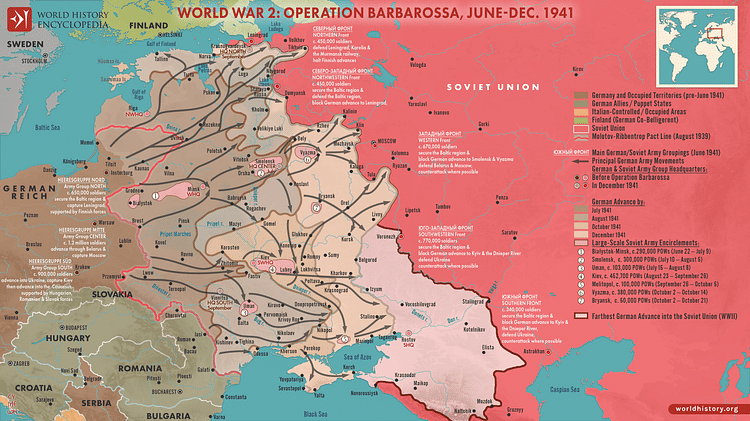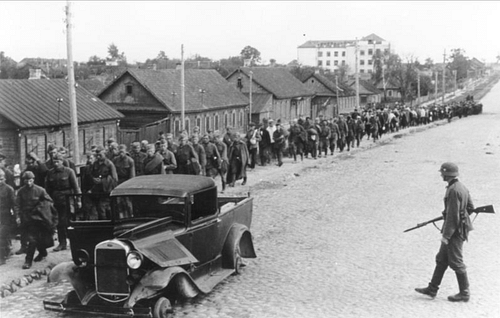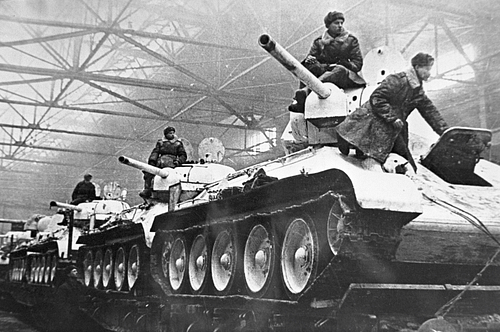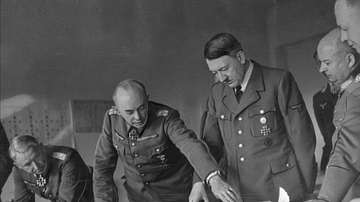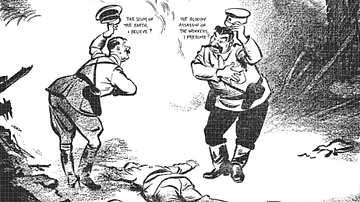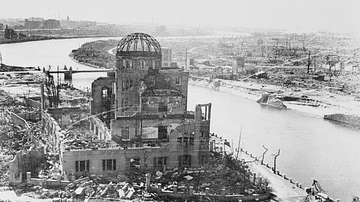
The German-Soviet War, known in the USSR and today's Russia as the Great Patriotic War or, in Western Europe, as the Eastern Front of the Second World War (1939-45), began in June 1941 with Operation Barbarossa and ended in Germany's total defeat in May 1945. The German-Soviet campaign involved such key battles as Kiev (Kyiv), Moscow, Leningrad (Saint Petersburg), Stalingrad (Volgograd), and Kursk. This particularly brutal front of the war witnessed the largest troop movements, sieges, and battles in history, as well as tens of millions of combatant and civilian deaths.
Hitler v. Stalin
Adolf Hitler (1889-1945), leader of Nazi Germany, attacked the USSR on 22 June 1941 with the largest army ever assembled. Despite the two states signing the Nazi-Soviet Pact in 1939, a non-aggression agreement, Hitler was ready in 1941, having conquered most of Western Europe, to turn his attention to the East. Hitler hoped to smash the Soviet Red Army and grab huge swathes of territory, what he called Lebensraum ('living space') for the German people, that is, new lands in the east where they could find resources and prosper. Of particular interest were resource-rich regions in Ukraine and the Caucasus oil fields. Other reasons for the attack included the belief that the leader of the USSR, Joseph Stalin (1878-1953), intended to attack Germany's vital source of oil from the Ploiești fields in Romania and Hitler's desire to destroy Bolshevism, the ideological enemy of Nazism. It was also hoped that knocking the USSR out of the war would oblige Britain to sue for peace. Finally, conquest would represent new opportunities to further impose Nazi race theory, since Jewish people and Slavic people were regarded as politically or racially inferior to the Nazis and Germanic people.
Hitler was confident of victory and promised his generals, "We'll kick the door in and the house will fall down" (Stone, 138) in a matter of weeks. The lack of a plan B if this did not happen was a serious flaw in the whole operation. Not for the first time, a Western European army would head into the vast depths of Russia unaware it faced not one enemy but three: the opposing army, the problem of logistics, and the harsh winter conditions. Stalin called the fighting on the Eastern Front (his Western Front) a 'Patriotic War', and he demanded total resistance to the invaders. The Soviet people, both military and civilian, men and women, certainly rose to the occasion.
Key battles of the German-Soviet War included:
- Battle of Białystok-Minsk in 1941
- Battle of Smolensk in 1941
- Battle of Kiev in 1941
- Battles of Kharkov in 1941, '42, and '43
- Siege of Leningrad in 1941-44
- Battle of Moscow in 1941-2
- Siege of Sevastopol in 1941-2
- Battle of Stalingrad in 1942-3
- Battle of Kursk in 1943
- Battle of Smolensk in 1943
- Battle of Berlin in 1945
Operation Barbarossa
Hitler's offensive of June-December 1941 was code-named Operation Barbarossa ('Redbeard') after Frederick Barbarossa, Holy Roman Emperor (r. 1155-90), who, legend has it, will one day return to ensure Germany is made great again. The attacking armies were mostly German but included significant units from Hitler's Axis allies: Italy, Romania, Slovakia, Hungary, and Finland, amongst others. The largest army ever assembled in history was experienced, well-organised, and highly confident. The invading force was divided into three army groups: North, Centre, and South. The Axis Air Force, as the Soviet Red Air Force would be, was largely restricted to ground support throughout the German-Soviet War. Similarly, the Soviet navy played only a limited role, notably in the Black and Baltic seas. In short, "the German-Soviet war was conducted predominantly on the ground" (Dear, 341).
The invaders moved forward on a wide front stretching from the Baltic to the Black Sea. The Axis advance went very well in the first few months. Over two million enemy soldiers were captured in huge pincer movements at battles in and around cities like Minsk, Smolensk, and Kiev. The route to Moscow was opened, and it seemed that Hitler had been right in his promise that the USSR would collapse sooner rather than later.
In the summer of 1941, the Red Army, purged by Stalin in the 1930s, was weak and disorganised. The Red Army in WWII was made up of conscripts from across the USSR who often had little will to fight. There were also penal battalions made up of convicts (including political prisoners), which, in total, numbered around 440,000 men. In addition, "at least 800,000 women served in Soviet forces during the war" (Rees, 162) in both combatant and non-combatant roles.
Most Soviet tanks and aircraft were obsolete in 1941, there was a chronic lack of transport vehicles, and communications were poor. The Axis Blitzkrieg ('lightning war') tactics of using fast-moving and combined arms – tanks, artillery, aircraft, and infantry – reaped dividends against a slow-moving, infantry-focused enemy. Blitzkrieg, though, was not designed to take cities, and here the invaders began to get bogged down. The siege of Leningrad (Saint Petersburg), which began in September 1941, and the rugged defence of Moscow at the close of 1941, gave Stalin and the Red Army hope that all was not lost. It was significant, too, that civilians were willing to defend Stalin's dictatorship even if they did not support it. Defeating the invaders became the priority. At Leningrad, 40,000 civilian men and women formed militia units to help defend the city, and at Moscow, 600,000 civilians helped build the capital's defences.
As winter set in at the end of 1941, the weaknesses of the Axis logistics across hundreds of miles of poorly roaded territory began to become a serious problem, as was a general lack of sufficient reserves. Hitler had not planned for a long campaign, but Stalin had done just that. A great deal of heavy industry had already been moved to the safety of Central and Eastern Russia, and so Stalin was able to resupply his armies much better. Axis logistics were also severely challenged by Stalin's orders that partisans sabotage Axis supplies whenever and wherever possible. Winter conditions, when temperatures plummeted to -35 degrees Celsius (-29 Fahrenheit), caught the invaders out when lubricants and fuel froze solid (Soviet equivalents had antifreeze to prevent such debilitating problems). Even digging trenches and shelters in the frozen soil proved difficult, and countless Axis soldiers froze to death.
The Soviet Fightback
Hitler's ambitions in the East were greatly affected by developments elsewhere in the war. The Japanese attack on Pearl Harbour, the United States naval base in Hawaii, in December 1941 had certain knock-on effects besides the mighty US entering the war. With Japan concentrating on the Pacific, it was no longer a direct threat to the USSR, and so Stalin was able to bring fresh troops from Siberia and Eastern Russia into the German-Soviet conflict.
Another boost for the Red Army from 1942 was in better weaponry. The 26-ton T34 medium tanks, for example, were being produced in greater numbers. These tanks were superior in firepower, armour, and mobility compared to any the Axis armies fielded, and they could resist most anti-tank guns. Another very effective Soviet weapon was the BM-13 Katyusha rocket launcher, known as 'Stalin's Organ'. Mounted on a truck, this weapon could rapidly fire 16 132-mm solid-fuel rockets. The problem was to get enough of these weapons made and delivered to where they were most needed.
The Soviet fightback began in January 1942 when Stalin's best general, Georgi Zhukov (1896-1974), organised an offensive to push the invaders back from Moscow. The Red Army was toughened up with punishments imposed on those who did not fight as required. Stalin even ordered that deserters should be summarily shot. The Soviets were also learning from the enemy; for example, they began to better use their tanks in larger and more effective groups. The Red Army pushed the Axis forces some 175 miles (280 km) from Moscow.
The German-Soviet War had turned into a war of attrition. The Axis armies were suffering losses in men and material which could not be sustained long term. Even when they won battles, as the Axis armies did in Crimea in the summer of 1942, the losses were irreplaceable. The USSR, on the other hand, could draw on much deeper resources than the invaders. In 1942, Germany produced 15,409 aircraft and 9,200 tanks to the USSR's 25,436 and 24,446, respectively (Stahel, 442). In addition, the USSR was helped by the US Lend-Lease programme, which gave aid amounting to around 7% of Soviet industrial production. By the end of 1942, Hitler's decision to invade the USSR looked like sheer folly. The Red Army might have been a pussycat pushover in 1941, but it had grown into a terrible tiger one year later.
A Dirty War
No war is ever free of brutality, but the German-Soviet conflict was worse than most. German soldiers had been given the freedom to shoot captured political officers (commissars) of the Red Army and commit atrocities against Soviet civilians. Special mobile killing squads, the Einsatzgruppen, executed Jewish and Slavic people as the Axis frontline moved forward. Some historians have suggested that had Hitler developed a more sympathetic attitude to the people he conquered, they might have aided him in his fight with Stalin. As it was, the brutality brought nothing but hatred.
The Nazi-occupied areas were subjected to the same terrors as had been seen in other occupied areas. The Gestapo, the Nazi secret police, soon moved in. Sometimes entire villages were wiped out and their residents shot if the Nazis thought they had supported partisans. Jewish people who were not immediately shot were rounded up into ghettos and then, along with others, like the Romani people, transported to concentration and death camps like Auschwitz, where millions were murdered in gas chambers. Hitler's plan for occupied territories was "First, to dominate it; Second, to administer it; Third, to exploit it" (Shirer, 941).
The Red Army was equally guilty of war crimes, as the fundamentals of the Geneva Convention were often entirely ignored, and prisoners of war were poorly treated – fewer than one in ten Axis prisoners ever returned home after the war. A vicious cycle of revenge acts marked the conflict. Even liberation did not end the potential for atrocities. Many Soviet civilians were publicly hanged by their liberators, having been accused of collaboration with the enemy.

Stalingrad: The Tide Turns
The huge battle for Stalingrad, fought between July 1942 and February 1943, became a symbol of the Eastern Front, its horrors, gigantic scale, and futility. The loss at Stalingrad resulted in the destruction of the entire German Sixth Army and the surrender of 91,000 troops, including Field Marshal Friedrich Paulus (1890-1957). The non-German Axis armies also suffered heavy losses. Italy lost 110,000 men (killed or wounded), Hungary 143,000, and Romania 160,000. These allied countries could not replace such losses. One of the greatest victories of the USSR in WWII, Hitler's armies never recovered either psychologically or materially and thereafter fought a defensive war of retreat. Two million civilians died at Stalingrad, and Stalin officially awarded the city 'Hero' status. The tide of the German-Soviet War had definitively turned.
More Red Army Victories
The debacle at Stalingrad, and the Axis campaign in general, was not helped by Hitler's refusal to allow any withdrawals, and so generals in the field were, in the end, obliged to surrender rather than retreat and regroup. Hitler was obliged, too, to divert millions of Axis troops to face the Western Allies' invasion of Italy from July 1943 and D-Day in Normandy in June 1944. Fighting on two fronts was something Germany simply did not have the capacity to carry out with long-term success.
In 1943, Hitler could still field 3 million troops on the Eastern Front, but Stalin had 6.6 million at his disposal (Dear, 347). The Red Army won the Battle of Kursk in the summer of 1943. Involving over 6,000 tanks, this was the largest tank battle in history and another massive drain on Hitler's ever-dwindling resources. The Soviets were now pushing along a huge front, driving the invaders out of Soviet territory. Smolensk was liberated in September. In the winter months of 1943/4, Axis forces were removed from Ukraine. In January 1944, Leningrad was finally liberated. In the summer of 1944 and during Operation Bagration – where the Red Army fielded around 2.4 million troops, 5,200 tanks, and 5,300 aircraft – the Axis Army Group Centre was destroyed. Russia itself was now free of the invaders. The Red Army soon established a foothold in eastern Poland and was pushing into Lithuania and threatening Germany itself. In August 1944, Germany's Axis ally Romania surrendered. In December, the Red Army lay siege to Budapest. The defenders had become the invaders.
The Battle of Berlin
Hitler's armies had advanced over 2,000 km (1,240 mi) into the USSR since the beginning of the war, but they were eventually pushed back into Germany itself. In January 1945, the Soviets launched the largest single offensive of the entire war. The target was Berlin. The Red Army had an advantage of about 10:1 in troops for this final push. Vienna was reached in April. On the other, Western Front, British and US Armies had crossed the Rhine the month before. As attention began to turn to who would control what in a post-war Europe, the Allies were racing each other to see who could capture Berlin first.
Berlin had several concentric circles of defences, the outer one being some 32 km (20 mi) from the city centre. The defence of the German capital, which involved around 400,000 troops, even roped in the Hitler Youth as the Führer called for Berlin's defence to the very last man (or boy) and the very last bullet, but this was all to no avail. Three Soviet fronts were formed – a total of 2.5 million soldiers, 6,250 armoured vehicles, 10,400 guns, and 7,500 aircraft – to crush the heart of the Third Reich. Berlin had already suffered heavy damage during a sustained Allied bombing campaign. On the ground, the capital's suburbs were reached by 25 April. Fighting went on from street to street, with those troops holding underground stations and canals proving most resistant, but it was merely a question of when Berlin would fall, not if. The flag of the USSR was hoisted over the Reichstag, the German Parliament building, on 30 April. Hitler committed suicide in his Berlin bunker that day. On 2 May, the Berlin garrison surrendered. Countless civilians now suffered the looting of their property, rape, and murder as the Red Army soldiers were given three days to do as they wished with the conquered, hated enemy. Germany formally surrendered on 7 May.

Aftermath
The USSR had won the German-Soviet War, but the cost had been a terrible one to pay. The conflict accounted for at least 25 million military and civilian deaths, perhaps half of the overall WWII death toll. Over 8 million Red Army soldiers died during WWII. Another 5.7 million Red Army soldiers were captured during the war, and 3.3 million of these died in captivity (Rees, 57). "1,710 cities and 70,000 villages were partially or completely erased" (Fowler, 215). Stalin oversaw a huge victory parade in Moscow's Red Square on 24 June 1945.
The German-Soviet War's legacy has endured. The USSR was determined not to allow such an invasion from the West ever to happen again and so reshaped Central and Eastern Europe to that end. An "iron curtain" was drawn between East and West, with Germany split in the middle. The curtain of division may have been raised in the 1990s, but even today, suspicion on both sides of future motives and ambitions continues to influence the continent's geopolitics.
